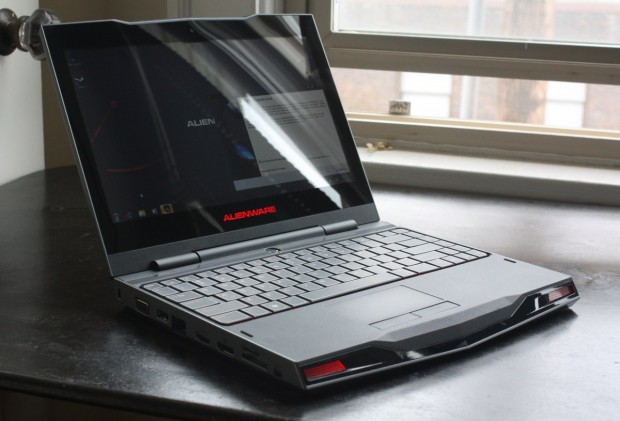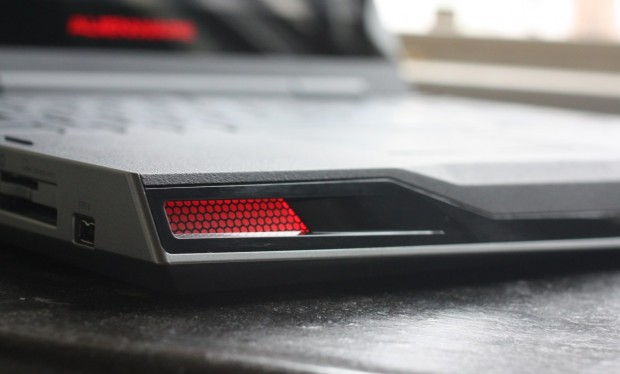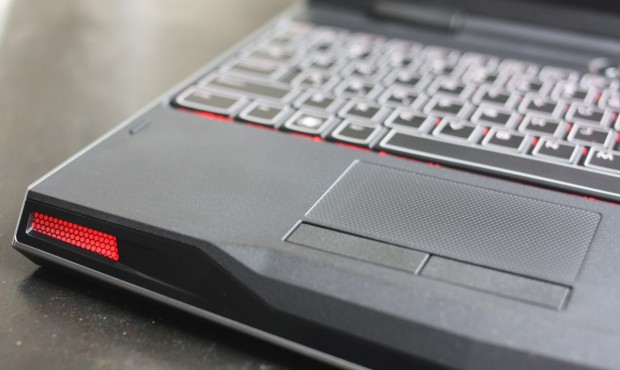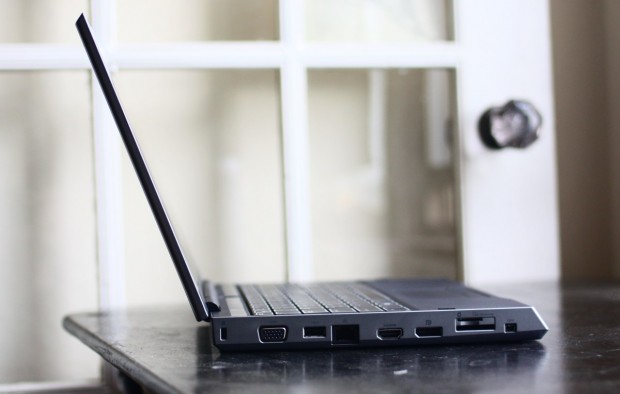
Short version: It’s not an all-in-one gaming solution, but for under $1000 it’s a sleek and relatively powerful machine with a few compelling features. Hope you like LEDs.
Features:
- Hybrid graphics
- 11.6″, 1366×768 display
- Low-voltage CPU for extended battery life
- Sexy looks
- MSRP: Starts at $799; $1099 as configured
Pros:
- Powerful enough for most modern games at medium settings
- Very good-looking machine
- Plenty of ports
Cons:
- Screen is very glossy and has limited sweet spot
- No optical drive can make for trouble
- Heavy for an ultraportable
Full review:
One of the things you generally feel you’re giving up when buying into a sub-$1000 notebook (to say nothing of such a small one) is gaming. Let’s be honest: it’s not practical. The components necessary to play modern games suck power and are physically quite large, right? To some extent, yes, but mobile GPUs and low-voltage CPUs have gotten to the point where they’re able to push a fair amount of polygons, and the M11x represents a sort of tipping point. While you won’t be blown away by the performance if you’re a PC gamer, you will be pleasantly surprised.
Before further talk, let’s just get the specs for our review unit out there:
- Processor: 1.3GHz Intel U7300 (overclocked to 1.73GHz)
- RAM: 4GB PC3-8500 DDR3
- GPU: NVIDIA GT 335M (switchable to Intel integrated)
- OS: Windows 7 Home Premium 64-bit
- Storage: 500GB HDD
- Ports: 3xUSB 2.0, HDMI, VGA, DisplayPort, IEEE1394, card reader (SD, MMC, MS, MS Pro), 2×3.5mm, mic jack
That’s for $1099, by the way. the $799 version has a normally clocked processor, 2GB of RAM, and a smaller hard drive. I feel that the processor is the main thing you’d want to upgrade, or you’ll see a definite performance hit.
As you may have noticed when I posted a gallery of glamor shots, the M11x is a very nice-looking machine. It feels very solid when you’re carrying it around, and I didn’t notice any disturbing bending or creaking when I picked it up from one corner. It’s extensively lit up, and you can choose pretty much any color for the keyboard, alien head, rear logo, and “vents” independently. Because you can’t vary the brightness, however, many of the colors seem over-the-top. A dimmer would have been very welcome.
The keyboard is attractive and the backlighting helpful (when it’s not blasting your eyes late at night), and I found it comfortable to type on, though a little soft. The trackpad is decent, though the buttons are really bad. They seem undersized and squishy, and I always felt I was being prevented from pushing them by the portion of the case surrounding them. Fortunately, as a gaming machine, it’s likely to have a mouse nearby, obviating this issue for the most part.
The webcam is functional and performs the face-recognition security that Alienware is so fond of, and which of course can be fooled with a photograph. Don’t hide your secret of secrets on this thing.
There are plenty of ports for you to use, and they’re generously spaced, unlike my Mac’s. Having USB slots on both sides is welcome, and the two headphone jacks are a nice touch as well for multiplayer gaming. The bottom of the laptop has a little battery charge indicator, which is handy when you’re just grabbing the laptop to go and want to know whether you’ll have to find an outlet wherever you’re headed — or for seeing whether it’s fully charged yet.
The M11x does not have an optical drive. Sure, that’s a trend recently, and it’s justified in computers where the main selling point doesn’t come on DVDs. I mean, of course you have Steam and Direct2Drive and all that, but if you own a physical copy of Crysis like I do, you’re out of luck. It’s a limitation that isn’t necessarily a deal-breaker, but for many, an optical drive is still essential. Puzzlingly, the M11x comes with a Windows 7 restore disc. Okay…?
If you’ve read CrunchGear’s laptop reviews before, you’ll know we’re not really big on benchmarking. After all, unless you’re willing to go all out and do every serious synthetic benchmark, it’s kind of useless. Those particular nuts and bolts are handled better by those who write hardware reviews exclusively, and you’re probably going to check out some of those reviews too. You’re here for the broader questions regarding this thing: does it play the games you want it to play, does it die super fast, and is it worth the money?
Does it play?
Yes it does. As long as you adjust your expectations, you’ll be happy with the results in many of the newest games. You need to keep in mind that some effects are CPU-intensive, though (some lighting and shadow effects which use ray-tracing, particle effects and physics) so it’s a good idea to turn those down first if you’re getting low framerates. But the limited resolution means that there won’t be that much horsepower required, so you can usually set visual settings pretty high — anyway, at that rez you won’t be able to notice the difference between “high” and “ultra” settings in a lot of cases. You will want anti-aliasing, though; 768 vertical pixels means you’ll see jaggies for sure.
Portal, TF2, and Half-Life 2 ran well; with detail maxed out and medium AA and AF settings, they both ran at an average of 80-100FPS. In tamer situations it approached 150-160FPS, and I only saw it dip below 30 or 40 once or twice for a few frames. Wolfenstein ran well, around 40-50FPS for the most part; unfortunately on the small screen a lot of texture detail is lost. Similar results could be found in MW2, Mass Effect 2, and Borderlands. Generally you’d peak around 55-70 FPS with CPU-hogging features reduced, with an average around 40 and the occasional dip into the 20s. There were a few choppy moments to be sure during big firefights, but they were outweighed by the fact that it was usually smooth and also that it looks good. Remember, we’ve got settings on high here. You’re not compromising your gaming experience much at all.
I also had some issues with the screen, and I’m not the only one. Although it says it’s LED-backlit, I didn’t find it particularly bright, and the vertical viewing angle was extremely narrow. It’s a good time to note that putting things on an external monitor or projector is a fantastic idea with this thing. Bring an HDMI cable with you and you’re looking at a solid HTPC as well as a games machine. I plugged mine into an HD projector from Acer and it worked great; there’s even a dedicated button for switching between external monitor modes.
Another thing to note is that the switch between discrete and integrated graphics, while straightforward, is not seamless. It blacks the screen out and asks you to quit some applications when you do it. Not wildly inconvenient, I admit, but why is it that way when NVIDIA has already released an improved version of the discrete/integrated switch that is far more seamless?
Does it die?
Yes it does. If you were to start up a modern game like Mass Effect 2 and unplug the M11x at the same time, you’d maybe get about two and a half hours of play time. It depends on how hard the game is working your hardware, of course, and you can increase battery life by using headphones and dimming the screen, but you don’t get too much more out of it. 2 1/2 hours is about the max — for performance mode.
For the battery-conserving, power-sipping integrated graphics mode, you can expect between six and eight hours — casual use like writing and reading will put you at the eight hour end, while video-watching and high-speed web stuff will obviously suck it dry a little faster. It’s perfectly reasonable life for a computer this size.
So you won’t be doing any marathon sessions while in a plane. I mean, not that we expected it; Alienware can’t break the laws of physics. But it’s more than enough time for a few levels of a shooter, or to watch an entire HD movie.
Is it worth the money?
I think it’s a pretty good deal — if you know what you’re getting into. This isn’t a miracle machine, it’s a competent performer with an unexpected price and form factor. Chances are it’s going to be revised relatively soon with improved hardware, some tweaks to the design, and maybe an external Blu-ray drive as an option. I realize that “it’ll be better later” is a pretty weak reason not to recommend something, but I have to resort to it now. The “compact gaming laptop” is a new thing, as evidenced by everyone’s surprise at the competency of the M11x. Since it’s new, it’ll be improved significantly soon, unlike many other laptop price points and form factors, where the differences between models are few and far between.
If you must buy, I would say upgrade the CPU but don’t bother with the RAM; 2GB should be enough for most games at the settings you’ll be at. Similarly, don’t worry about a hard drive upgrade. Take the hundred bucks you would have spent and get yourself a nice external you can keep your HD content and miscellany on. You can always add RAM later.
The M11x isn’t a heavy hitter, but it’s a great little machine and if you’re a gamer, I can think of worse ways for you to spend a thousand dollars. Just read the reviews and be sure to consider whether you can live with the compromises necessary to get modern gaming into this sexy little shell.













